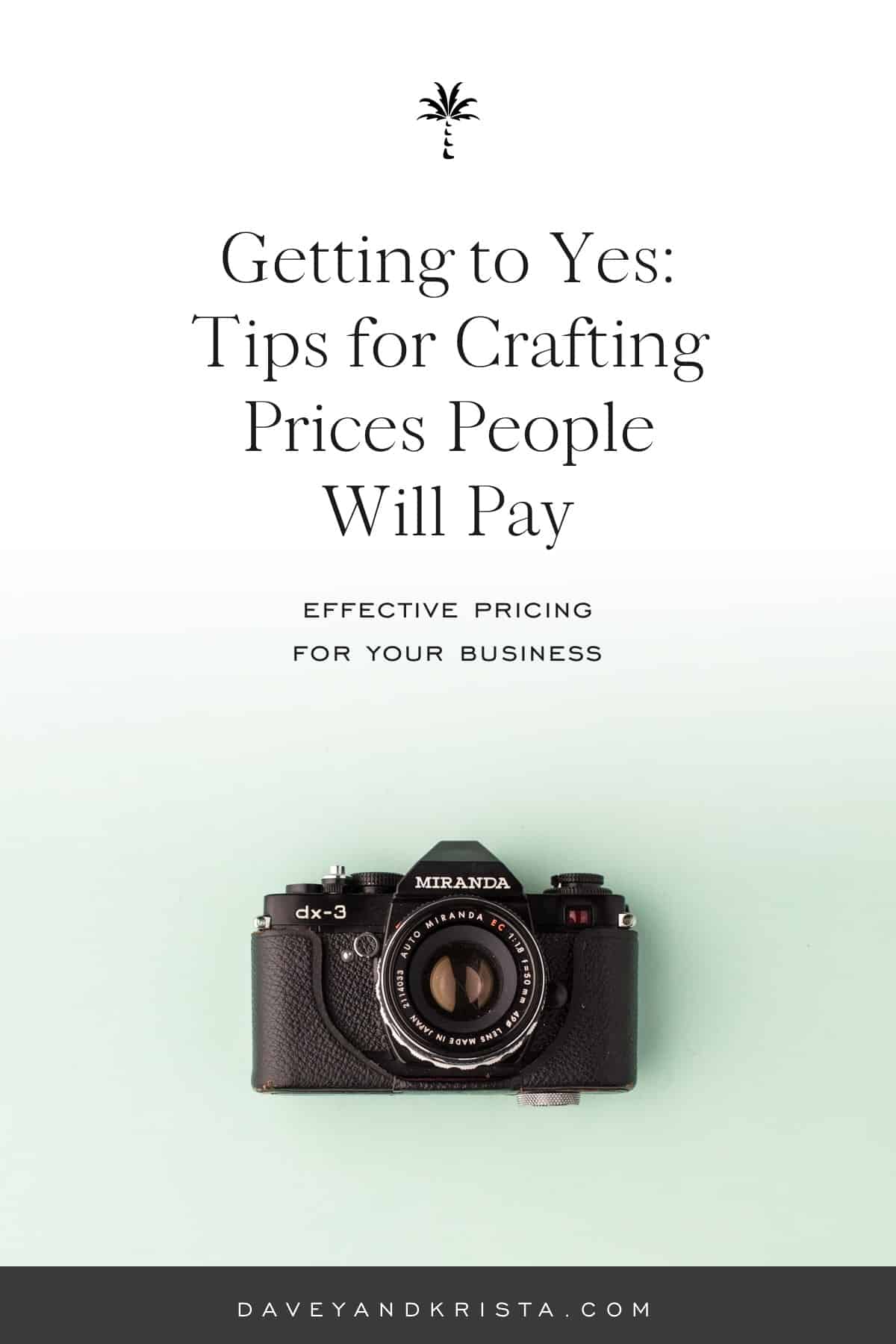We’ve discussed this before, but being good at what you do is simply not enough much of the time.
For better or worse, people don’t compare products and services objectively. Instead a variety of factors—many of which we are not conscious of—impact our purchasing decisions.
And at least a hot few of those factors have to do with pricing, such as how we assign or perceive value, and how services and prices are presented to us.
I’d argue that crafting the right offer is one of the most important aspects of becoming a profitable, thriving business. An effective offer is easy-to-understand, demonstrates clear value, educates and overcomes objections.
This post explores tips for service providers who want to craft effective pricing ‘collections’ or ‘packages’ for their business.
Why You Should Create Collections of Services
When possible, create pricing collections or packages instead of presenting all the options as ‘a la carte.’
Giving clients the opportunity “build their own” package sounds good in theory, but science suggests that too many choices can overwhelm a person and prevent one from making a decision.
Consider this study* from the Journal of Personality and Social Psychology where two social scientists offered free samples of jam at a grocery store. In the first week, they offered twenty-four different varieties of jam and only 3% of tasters purchased. The following week they offered only six jams and 30% of tasters purchased.
That is a significant increase.
Eliminating options can help leads make decisions more efficiently. Presenting only six variations of jam still gave tasters the perception of choice while also not overloading them with options.
But beyond that, collections can also be used as an effective way to educate clients by indicating those things that are important.
When we were shooting weddings, we found that couples who had done engagement sessions were likely to have much smoother wedding days. So, we decided to add an engagement session to all of our collections. It became an opportunity for us to share with our clients about why an engagement session is important, and it was extra time that we got to spend with them prior to their wedding day.
How to Create Your Pricing Collections
We usually recommend creating somewhere between 3 and 5 collections. As we saw in the study above, too many collections can overwhelm.
What Items to Put in Each Collection
Try thinking through different client profiles and what those clients might need as you create your collections. There are likely ‘typical’ items that will likely need to be in a collection. For instance one collection might look like this:
But you should also think about those things that clients might not ask for, but ought to ask for. Remember, this is a good opportunity to educate clients about what’s important and things that set you apart.
I coached a husband and wife brand photography team who happen to be very talented stylists. In their original collection sheet, they had styling listed as an ‘a la carte’ item. However, they admitted to me that this is something they ended up doing for clients anyways even if the client didn’t select it.
I encouraged them to build it into their collections because most of the time they ended up doing it anyways, and it was one of the most remarkable things about their client experience. Clients who experienced that aspect of their service would be more likely to share their names with others or hire them again.

How to Price each Collection
Your most inexpensive and expensive collections are going to serve important purposes, so you’ll want to make sure to think through them carefully.
Anchoring Your Prices – Your Most Expensive Collection
Your most expensive collection should have all the bells-and-whistles that one might want if they’re the kind of people who want everything.
This option will likely not be selected often, but it still serves an important purpose.
It serves as your anchor price: It makes the next collection look that much more valuable in comparison. Once an ‘anchor price’ is effectively set, it’s the price that will be compared to every other price.
The most expensive collection should be the first one presented to a potential client.
If you notice clients are frequently booking your top collection, that’s probably a pretty good indicator that it’s time to raise your prices.
Your Most Inexpensive Collection
On the other hand, the most inexpensive collection should be no less than the bare minimum that will get you out of bed. I call it ‘the-get-out-of-bed’ fee.
This is different than putting together a collection based on the bare minimum that someone might want.
The get-out-of-bed fee is helpful because it’ll prevent you from tying up your time with lower-value clients that prevent you from taking higher value clients that might come along.
For instance, someone might want only 5 hours of photography coverage at their wedding. If you decide to work that wedding, you’re now unable to take an 8-hour wedding at a higher rate that might come along. Are you okay with that?
When we were shooting weddings, we found that we didn’t like working weddings that were less than 7 hours because we did almost as much work, but had to do it in less time. Additionally, we didn’t feel like we could provide the same level of service for a 5 hour wedding.
As a result, our ‘lowest’ collection provided 7 hours of coverage and was priced accordingly.
If you’ve priced your lowest collection appropriately, you should still feel good about committing to it. It shouldn’t be that much less
The Money Making Middle
So now you have an expensive collection that serves as an ‘anchor,’ and a lower collection that if someone books you’re still thrilled about because the money’s still good (instead of hating your life because you’ve committed to something that still requires the work of showing up but isn’t reflect in what you’re paid).
That leaves the middle collection, which should be the most frequently selection package.
Compared to the top collection, it should look like it offers a lot of value for less. And people comparing it to the bottom collection should feel like it’s a no-brainer because they’re getting more while not having to pay that much more.
The middle collection should include all of the typical things one might want when booking your service.
If you’re interested in a real life service that’s nailed down the science of pricing, go to a local ‘done-for-you’ carwash (not one that’s just a drive-thru). I don’t have numbers, but my guess is that the majority of people who go choose one of the middle-higher packages.
Presenting Your Prices
How you present your prices is almost as important as the prices themselves. If you’ve followed the tips above, you’ve already put together collections that are easier for your potential clients to understand.
Now how can we present that information effectively that encourages clients to purchase?
Create a Pricing Guide
If you’re providing a relatively expensive service, you’ll want to make sure you focus on the experience that you provide.
Instead of just putting together a pricing-sheet, create a guide that introduces your business, highlights the experience that you provide and that past clients have had, and then presents your prices.
This can either be done as a PDF or in a ‘private’ page on your website. The advantage of including it as a ‘private’ page on your website is that it’s easy to update and you don’t have to worry about clients not being able to load email attachments. It’s also a little easier to send when you’re ‘on the go’.
Does the ‘Pricing Dead Zone’ exist?
Yes, most likely.
The ‘pricing dead zone’ is when lower end clients feel you’re too expensive, while high end clients feel you’re too cheap.
Unfortunately there’s little one can do to know definitively whether they’re in the ‘pricing dead zone’ because it’s going to be different from market to market.
There are, however, a few indicators such as people frequently choosing to go with more expensive or less expensive competitors.
Regardless, it doesn’t do much good to speculate.
What will help one determine whether to change their prices is tracking inquiries. Determining when to raise or lower prices can be its own puzzle. The one thing you’ll need to be doing so that you can make the most informed decision is tracking your inquiries.
This way you know what times of the year you receive the most inquiries, and what times of year are generally slower.
Why does this matter? Because if you raise your prices during a slow time of year—but don’t realize that it’s generally slower—and no one books, you might think it’s because of your price hike or the ‘pricing dead zone.’ When, in reality, it’s just a slow time of year.

Have questions? Looking for more resources?
We’ve written quite a few posts about pricing, which you can access at https://daveyandkrista.com/tag/pricing-strategy.
And we’re always happy to answer questions. Just drop them in the comments below!
*Link to study referenced above: When Choice is Demotivating: Can One Desire Too Much of a Good Thing.







VIEW THE COMMENTS
Add A Comment